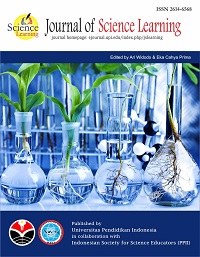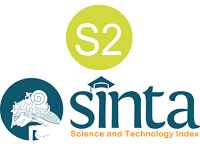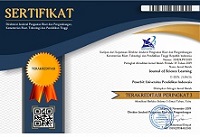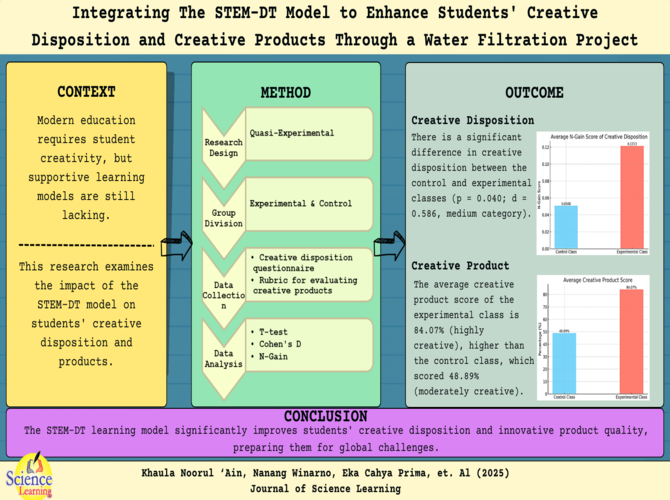
Integrating The STEM-DT Model to Enhance Students' Creative Disposition and Creative Products Through a Water Filtration Project
Abstract
Education in the modern era requires students to have high creative skills to face the challenges of a complex world. However, the lack of teaching learning models that foster students' creativity is a common problem in classroom learning. This research aims to explore the impact of the STEM-DT (Science, Technology, Engineering, and Mathematics-Design Thinking) learning model on students' creative disposition and creative products. A quasi-experimental design was used, involving two groups: an experimental class using the STEM-DT learning model and a control class employing conventional teaching methods. The participants consisted of 52 junior high school students. Instruments included a creative disposition questionnaire and a rubric for evaluating creative products. Data were analyzed using t-tests, Cohen's d calculations, and N-Gain measurements. The results indicated a significant difference in average creative disposition between the control and experimental classes, with a t-test significance value of 0.040 and Cohen's d effect size of 0.586 (medium category). The average N-Gain score of creative disposition in the experimental class reached 0.1213, while in the control class, it was 0.0508, showing greater improvement in the experimental group. Additionally, the average creative product score in the control class was 48.89%, categorized as moderately creative, while the experimental class scored 84.07%, categorized as highly creative. The findings suggest that the STEM-DT learning model significantly enhances students' creative disposition and the quality of innovative products, providing essential preparation for younger generations to navigate the complexity and dynamics of global change.
Keywords
Full Text:
Download PDFReferences
Ananda, L. R., Rahmawati, Y., & Khairi, F. (2023). Critical Thinking Skills of Chemistry Students by Integrating Design Thinking with STEAM-PjBL. Journal of Technology and Science Education, 13(1), 352-367.
Arifin, N. R., & Mahmud, S. N. D. (2021). A Systematic Literature Review of Design Thinking Application in STEM Integration. Creative Education, 12(07), 1558–1571. https://doi.org/10.4236/ce.2021.127118
Baran, M., Baran, M., Karakoyun, F., & Maskan, A. (2021). The Influence of Project-Based STEM (PjbL-STEM) Applications on the Development of 21st-Century Skills. Journal of Turkish Science Education, 18(4), 798–815. https://doi.org/10.36681/tused.2021.104
Besemer, S. P. (1998). Creative product analysis matrix: Testing the model structure and a comparison among products - Three novel chairs. Creativity Research Journal, 11(4), 333–346. https://doi.org/10.1207/s15326934crj1104_7
Chien, Y. H., Liu, C. Y., Chan, S. C., & Chang, Y. S. (2023). Engineering design learning for high school and college first-year students in a STEM battlebot design project. International Journal of STEM Education, 10(1). https://doi.org/10.1186/s40594-023-00403-0
Csikszentmihalyi, M. (2012). Creativity and genius: a systems perspective. Genius and the MindStudies of Creativity and Temperament, 38–65. https://doi.org/10.1093/acprof:oso/9780198523734.003.0003
Diep, N. H., Thuy, H. T. P., Lai, D. T. B., Viet, V. Van, & Chung, N. T. K. (2023). A comparison of three stem approaches to the teaching and learning of science topics: Students’ knowledge and scientific creativity. International Journal of Education and Practice, 11(2), 266–278. https://doi.org/10.18488/61.v11i2.3336
Guzey, S. S., & Li, W. (2023). Engagement and Science Achievement in the Context of Integrated STEM Education: A Longitudinal Study. Journal of Science Education and Technology, 32(2), 168–180. https://doi.org/10.1007/s10956-022-10023-y
Ha, V. T., Chung, L. H., Hanh, N. Van, & Hai, B. M. (2023). Teaching Science Using Argumentation-Supported 5E-STEM, 5E-STEM, and Conventional Didactic Methods: Differences in the Learning Outcomes of Middle School Students. Education Sciences, 13(3). https://doi.org/10.3390/educsci13030247
Han, J., Kelley, T., & Knowles, J. G. (2023). Building a sustainable model of integrated stem education: investigating secondary school STEM classes after an integrated STEM project. International Journal of Technology and Design Education, 33(4), 1499–1523. https://doi.org/10.1007/s10798-022-09777-8
Hiwatig, B. M. R., Roehrig, G. H., & Rouleau, M. D. (2024). Unpacking the nuances: an exploratory multilevel analysis on the operationalization of integrated STEM education and student attitudinal change. Disciplinary and Interdisciplinary Science Education Research, 6(1). https://doi.org/10.1186/s43031-024-00108-6
Horn, D., & Salvendy, G. (2006). Consumer-based assessment of product creativity: A review and reappraisal. Human Factors and Ergonomics In Manufacturing, 16(2), 155–175. https://doi.org/10.1002/hfm.20047
Kornhaber, M. L. (2019). The theory of multiple intelligences. The Cambridge Handbook of Intelligence, 659–678. https://doi.org/10.1017/9781108770422.028
Li, W., & Li, Z. (2022). Research on Creativity Model of Creative Product Design Based on Twenty-four Solar Terms. Proceedings of the 2021 International Conference on Culture, Design and Social Development (CDSD 2021), 634(Cdsd 2021), 305–310. https://doi.org/10.2991/assehr.k.220109.064
Li, Y., Schoenfeld, A. H., diSessa, A. A., Graesser, A. C., Benson, L. C., English, L. D., & Duschl, R. A. (2019). Design and Design Thinking in STEM Education. Journal for STEM Education Research, 2(2), 93–104. https://doi.org/10.1007/s41979-019-00020-z
Lucas, B. (2016). A five-dimensional model of creativity and its assessment in schools. Applied Measurement in Education, 29(4), 278-290.
Margolis, A. A. (2020). Zone of Proximal Development, Scaffolding and Teaching Practice. Cultural-Historical Psychology, 16(3), 15–26. https://doi.org/10.17759/chp.2020160303
Nasri, N., Rahimi, N. M., Nasri, N. M., & Talib, M. A. A. (2021). A comparison study between universal design for learning-multiple intelligence (Udl-mi) oriented stem program and traditional stem program for inclusive education. Sustainability (Switzerland), 13(2), 1–12. https://doi.org/10.3390/su13020554
Ning, Z., Salleh, S. M., & Cai, L. (2023). Design Thinking Promoting the Deep Integration of STEM and SEL. International Journal of Membrane Science and Technology, 10(2), 3016–3027. https://doi.org/10.15379/ijmst.v10i2.3040
Othman, M. Z., Hassan, Z., & Has, A. T. C. (2022). Morris water maze: a versatile and pertinent tool for assessing spatial learning and memory. Experimental animals, 71(3), 264-280.
Puchongprawet, J., & Chantraukrit, P. (2022). Creative Problem-Solving and Creativity Product in STEM Education. International Journal of Instruction, 7(2), 135–142. https://doi.org/10.29333/aje.2022.7211a
Sawu, M. R. F., Sukarso, A., Lestari, T. A., & Handayani, B. S. (2023). Effect of STEM Learning in Building Creative Dispositions and Creative Thinking Skills of Junior High School Students. Jurnal Penelitian Pendidikan IPA, 9(8), 6219–6229. https://doi.org/10.29303/jppipa.v9i8.4180
Shahbazloo, F., & Mirzaie, R. A. (2023). Investigating the effect of 5E-based STEM education in solar energy context on creativity and academic achievement of female junior high school students. Thinking Skills and Creativity, 49, 101336. https://doi.org/10.1016/j.tsc.2023.101336
Simeon, M. I., Samsudin, M. A., & Yakob, N. (2022). Effect of design thinking approach on students’ achievement in some selected physics concepts in the context of STEM learning. International Journal of Technology and Design Education, 32(1), 185–212. https://doi.org/10.1007/s10798-020-09601-1
Suciani, M. I., & Prima, E. C. (2020). Assessing Students’ Creative Disposition and Creative Product in Learning Newton Law. Proceedings of the 7th Mathematics, Science, and Computer Science Education International Seminar, MSCEIS 2019. https://doi.org/10.4108/eai.12-10-2019.2296344
Sukarso, A., Artayasa, I. P., Bahri, S., & Azizah, A. (2022). Provision of Creative Teaching Materials in Improving Creative Disposition and Creative Thinking Skills of High School Students. Jurnal Penelitian Pendidikan IPA, 8(6), 2728–2736. https://doi.org/10.29303/jppipa.v8i6.2514
Sulaeman, N., Efwinda, S., & Putra, P. D. A. (2022). Teacher Readiness in Stem Education: Voices of Indonesian Physics Teachers. Journal of Technology and Science Education, 12(1), 68–82. https://doi.org/10.3926/jotse.1191
Thi Hong, C. N. (2024). Lesson Plan Design Process Develops STEM Design Thinking Through Science Grade 4. International Journal of Social Science and Human Research, 7(04), 2497–2501. https://doi.org/10.47191/ijsshr/v7-i04-35
Thomason, D., & Hsu, P. L. (2024). The effect of a STEM integrated curriculum on design thinking dispositions in middle school students. International Journal of Technology and Design Education. https://doi.org/10.1007/s10798-024-09894-6
Topsakal, I., Yalçin, S. A., & Çakir, Z. (2022). The Effect of Problem-based STEM Education on the Students’ Critical Thinking Tendencies and Their Perceptions for Problem Solving Skills. Science Education International, 33(2), 136–145. https://doi.org/10.33828/sei.v33.i2.1
Wan, Z. H., So, W. M. W., & Hu, W. (2021). Necessary or sufficient? The impacts of epistemic beliefs on STEM creativity and the mediation of intellectual risk-taking. International Journal of Science Education, 43(5), 672–692. https://doi.org/10.1080/09500693.2021.1877368
Wan, Z. H., So, W. M. W., & Zhan, Y. (2023). Investigating the Effects of Design-Based STEM Learning on Primary Students’ STEM Creativity and Epistemic Beliefs. International Journal of Science and Mathematics Education, 21, 87–108. https://doi.org/10.1007/s10763-023-10370-1
Wingard, A., Kijima, R., Yang-Yoshihara, M., & Sun, K. (2022). A design thinking approach to developing girls’ creative self-efficacy in STEM. Thinking Skills and Creativity, 46, 101140.
Zhang, J. (2022). What Characterises an Effective Mindset Intervention in Enhancing Students’ Learning? A Systematic Literature Review. Sustainability (Switzerland), 14(7). https://doi.org/10.3390/su14073811
Zhao, L., He, W., Liu, X., Tai, K. H., & Hong, J. C. (2021). Exploring the effects on fifth graders’ concept achievement and scientific epistemological beliefs: Applying the prediction-observation-explanation inquiry-based learning model in science education. Journal of Baltic Science Education, 20(4), 664–676. https://doi.org/10.33225/jbse/21.20.664
DOI: https://doi.org/10.17509/jsl.v8i1.78982
Refbacks
- There are currently no refbacks.
Copyright (c) 2025 Khaula Noorul 'Ain, Nanang Winarno, Eka Cahya Prima, Marina Mokhtar

This work is licensed under a Creative Commons Attribution-ShareAlike 4.0 International License.
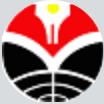

Jl. Dr. Setiabudhi 229 Bandung 40154, West Java, Indonesia






